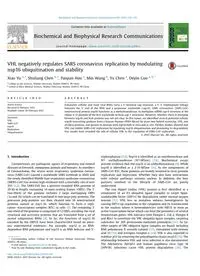
2015 VHL negatively regulates SARS coronavirus replication by modulating nsp16 ubiquitination and stability PDF
Preview 2015 VHL negatively regulates SARS coronavirus replication by modulating nsp16 ubiquitination and stability
VHL negatively regulates SARS coronavirus replication by modulating nsp16 ubiquitination and stability Xiao Yu a, 1, Shuliang Chen b, 1, Panpan Hou a, Min Wang b, Yu Chen a, Deyin Guo a, b, * a College of Life Sciences, Wuhan University, Wuhan 430072, PR China b School of Basic Medical Sciences, Wuhan University Wuhan, 430072, PR China a r t i c l e i n f o Article history: Received 8 February 2015 Available online 28 February 2015 Keywords: VHL SARS-CoV nsp16 Replication Ubiquitination a b s t r a c t Eukaryotic cellular and most viral RNAs carry a 50-terminal cap structure, a 50-50 triphosphate linkage between the 50 end of the RNA and a guanosine nucleotide (cap-0). SARS coronavirus (SARS-CoV) nonstructural protein nsp16 functions as a methyltransferase, to methylate mRNA cap-0 structure at the ribose 20-O position of the first nucleotide to form cap-1 structures. However, whether there is interplay between nsp16 and host proteins was not yet clear. In this report, we identified several potential cellular nsp16-interacting proteins from a human thymus cDNA library by yeast two-hybrid screening. VHL, one of these proteins, was proven to interact with nsp16 both in vitro and in vivo. Further studies showed that VHL can inhibit SARS-CoV replication by regulating nsp16 ubiquitination and promoting its degradation. Our results have revealed the role of cellular VHL in the regulation of SARS-CoV replication. © 2015 Elsevier Inc. All rights reserved. 1. Introduction Coronaviruses are pathogenic agents of respiratory and enteral diseases in livestock, companion animals and humans. As members of Coronaviridae, the severe acute respiratory syndrome corona- virus (SARS-CoV) caused a worldwide SARS outbreak in 2003 and the newly identified Middle East respiratory syndrome coronavirus (MERS-CoV) has serious high virulence with a mortality rate of over 35% [1,2]. The SARS-CoV has a positive-stranded RNA genome of 29 kb in length, containing 14 open reading frames (ORFs). The 50 two-thirds of the genome includes 2 large overlapping ORFs (1a and 1b) which can be translated to two large poly-proteins. The precursor poly-proteins are then cleaved into 16 nonstructural proteins named as nsp1-16, which function to form a repli- cationetranscription complex (RTC) in cells [3]. The remaining 30 one-third of the genome is comprised of 12 ORFs, encoding the viral structural and accessory proteins that are translated from a set of nested subgenomic RNAs [4]. So far, the functions of nsp12-16 encoded by the ORF1b have been characterized based on previ- ous experimental evidences. For example, nsp12 is an RNA- dependent RNA polymerase and nsp13 is an RNA helicase and 50- triphosphatase [5,6]. Nsp14 is identified as an exoribonuclease and N7- methyltransferase (N7-MTase) [7,8]. Biochemical assays provide evidence that the nsp15 is an endoribonuclease [9]. While nsp16 is identified as a 20-O-MTase [10]. As the components of SARS-CoV RTC, these proteins are mainly involved in virus genome replication and expression. Whether they also have interactions with cellular pathways remains unclear. In addition, the host partners involved in the lifecycle of SARS-CoV are poorly understood. The von Hippel Lindau (VHL) protein is first identified as a component of an E3 ubiquitin ligase complex to target hypo- xiainducible factor (HIF1a) for degradation under normal oxygen tension [11]. VHL loss or mutation induces tumorigenesis by causing HIF1a up-regulation in the cytoplasm and its translocation to the nucleus where it heterodimerizes with HIF1b to form an active transcription factor which can bind the promoters of several downstream genes. VHL interacts with Elongin C, Cul-2, Elongin B and Rbx1 to constitute the VBC ubiquitin ligase complex, targeting substrates for 26S proteasome-mediated proteolysis [11]. So far, other targets of VBC ubiquitin ligase complex are found, including RNA polymerase II seventh subunit [12], stimulated with retinoic acid 13 [13] and estrogen receptor-a [14]. VHL is also reported to stabilize p53 by removing the polyubiquitin chains on p53 [15]. The relationship between VHL and virus infection is also documented. The Adenovirus Ad5DE3 and human papilloma virus type 16 (HPV16) infections cause VHL protein degradation [16]. The * Corresponding author. College of Life Sciences, Wuhan University, Wuhan 430072, PR China. E-mail address:
